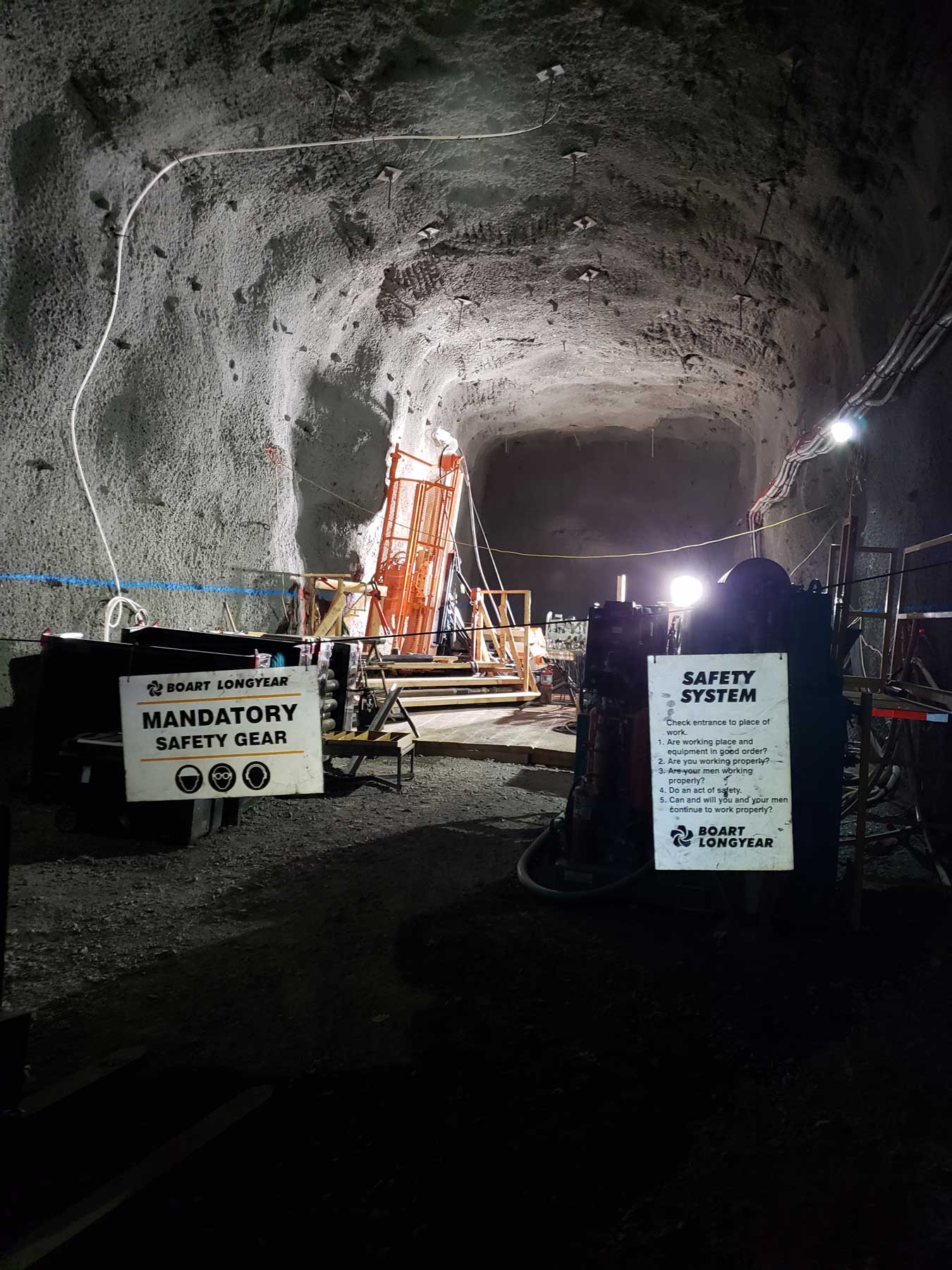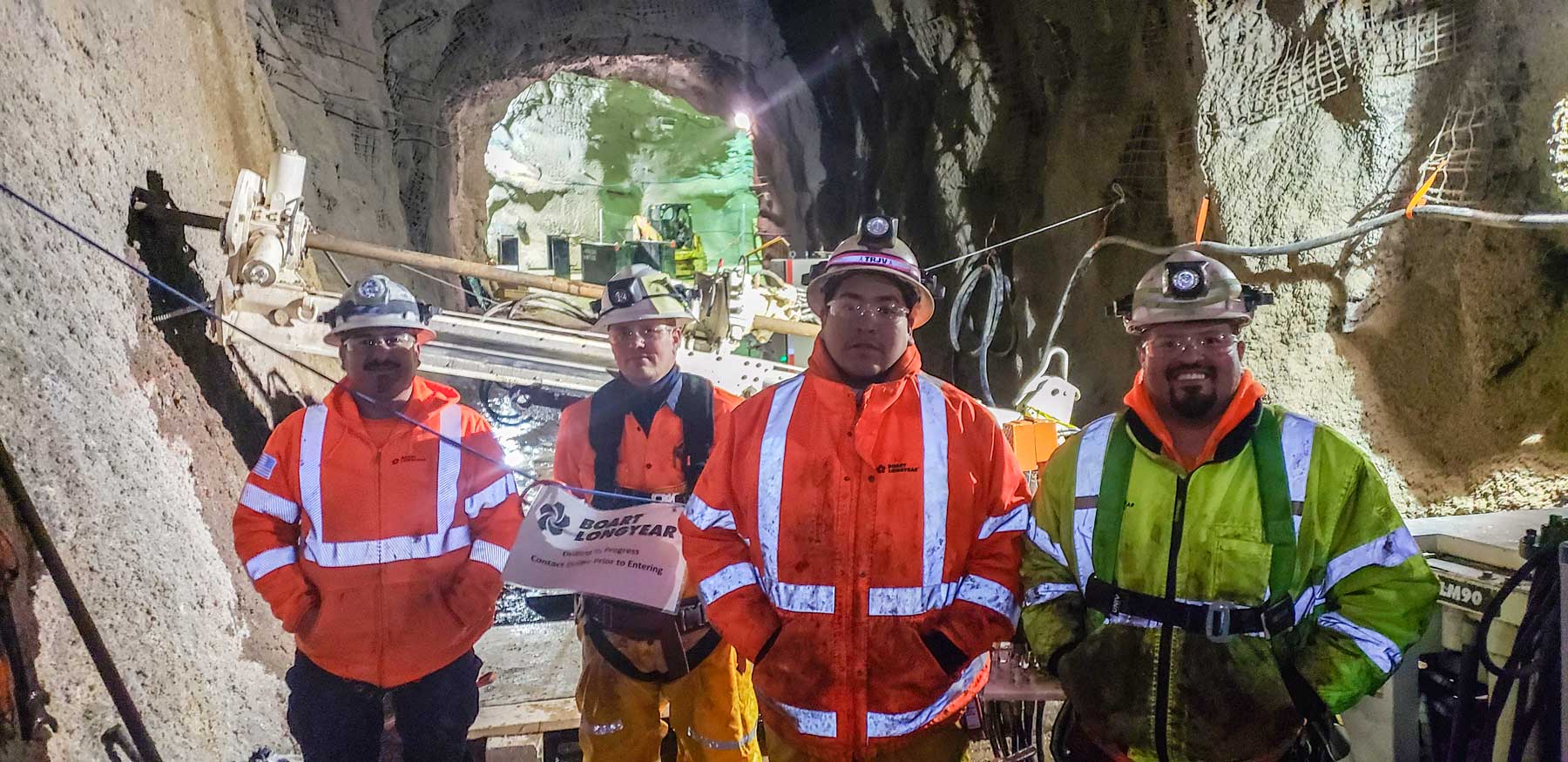ERKUNDUNG
29. Januar 2020
Erkundung der Möglichkeiten mit einfallsreichen Untertagebohrmannschaften und Ausrüstung
Das Erscheinen auf einer Mine, um unterirdische Diamantbohrungen durchzuführen, verläuft nicht immer genau wie geplant.
Bei einem bestimmten Projekt mobilisierte Boart Longyear unterirdische Bohrinseln zu einer Mine eines Kunden in den USA, wo die Mine mit einem großen Wasserproblem konfrontiert war, das die Fertigstellung der unterirdischen Explorationsbohrungen unmöglich machte. Die Mine hatte zwei Schächte, die sich auf verschiedenen Ebenen übereinander befanden. Der tiefere Schacht hatte Pumpen installiert und war bereit, Wasser an die Oberfläche zu pumpen. Der obere Schacht war jedoch mit Wasser geflutet - wo es keine Pumpen gab.
Anstatt zu versuchen, zusätzliche Pumpen in den überfluteten oberen Schacht einzubauen, um das Wasser zu entfernen, bewegte Boart Longyear die unterirdischen Bohrinseln zum unteren Schacht und bohrte eine fächerförmige Reihe von Aufbohrungen in den überfluteten Schacht. Die Idee ging auf und nutzte die Schwerkraft, um das Wasser vom oberen zum unteren Schacht abzulassen, wo die Pumpen das überschüssige Wasser an die Oberfläche befördern konnten. Die Mine konnte den Betrieb im oberen Schacht fortsetzen und Boart Longyear konnte mit den Explorationsbohrungen für Diamantbohrkerne beginnen.
Bei einem anderen Projekt galt die Mine als trocken. Nachdem die Untergrundbohrung begonnen hatte, fand die Boart Longyear-Crew schließlich Wasser - eine Menge davon, ganz unerwartet. Die Besatzung konnte einen Plan zur Bewirtschaftung des Wassers ausarbeiten, damit die Explorationsbohrungen abgeschlossen werden konnten. Nach der Druckinjektion in einem Zementkragenmantel wurden ein Ausblasschutz (BOP - zum Abdichten, Steuern und Überwachen von Wasser, um Ausblasen und das unkontrollierte Ablassen von Hochdruckwasser zu verhindern) und eine Steinpackung erfolgreich installiert, wobei der Ausblasschutz geschlossen wurde Wasser in. Die meisten Fälle, in denen diese Menge an Wasser angetroffen wird, spielen sich ganz anders ab. Jeder hat eine Situation erlebt oder kennt jemanden, in der ein hohes Wasservolumen all Ihre Werkzeuge aus dem Loch bläst, was zu einem komplizierten Durcheinander führt.
Untertagebohrgeräte auf Oberflächenprojekten
Weitere Beispiele für unerwartete Herausforderungen sind kreative Lösungen mit Boart Longyears eigenen unterirdischen Bohrinseln an der Oberfläche. Die Division Drilling Services Underground Coring mobilisierte Bohrinseln zu einem Minenstandort, an dem aufgrund einer Verzögerung bei der Exploration von Diamantbohrinseln die Bohrinseln an der Oberfläche im Leerlauf waren. Jemand sah die Rigs warten und fragte, ob die untätigen unterirdischen Rigs flachwinklige Löcher in die Oberfläche bohren könnten. Die unterirdischen Bohrinseln haben die Herausforderung angenommen und bohren seitdem diese niedrigen, flachwinkligen Bohrlöcher.
Das Bergwerksgelände verfügt über eine begrenzte Genehmigung für Oberflächenstörungen. Um die geologischen Formationen außerhalb des Bereichs der Störungsgenehmigung zu erreichen, betreibt die Division Underground Coring von Boart Longyear unterirdische Bohrgeräte auf der Oberfläche, um häufig flachwinklige Löcher zu bohren kann wegen ihrer LKW-montierten hohen Masten nicht erreichen.
Die unterirdischen Bohrgeräte können in geringen Winkeln von -40 Grad bis flach bohren. Sie bohren unterhalb des Bereichs, in dem der Bergbaukunde die Oberfläche nicht stören darf. Das bedeutet, dass Explorationsbohrungen Erzadern folgen können, ohne die Oberfläche zu stören, und unterhalb des Bereichs außerhalb der erteilten Störungsgenehmigung bohren können.
Die Bohrlöcher sind 792,48 m bis 822,96 m (2600 ft bis 2700 ft) in einem Winkel von -40 bis -12 Grad. Boart Longyear verfügt über die Werkzeuge und das Know-how für diese Art des Bohrens, konnte diese Aufgabe jedoch nicht mit Oberflächenbohrgeräten ausführen, da Sie sich bei flacher Aufstellung 3,66 m über dem Boden befinden, da der Mast weit oben liegt auf einem Lastwagen. Mit den unterirdischen Bohrinseln wurde eine Arbeitsbühne oder ein Deck gebaut, die es dem Team ermöglichten, in unmittelbarer Nähe zu arbeiten.
Eine vielseitige und einzigartige Flotte
Das Boart Longyear Drilling Services Untertagebohrung In den USA werden alle von Boart Longyear entwickelten und hergestellten LM ™ - und MDR-Bohrinseln betrieben. Die Bohrinseln der LM-Serie sind mit leicht austauschbaren Komponenten ausgestattet, die Platzmangel ohne Einbußen bei den Tiefenanforderungen berücksichtigen. Diese modularen Bohrgeräte bieten einen leichteren Zugang in engen unterirdischen Räumen und Mobilität für leichtere Bewegungen von Loch zu Loch oder Welle zu Welle. Das patentierte Werkzeug von Boart Longyear bietet sicherere und effizientere Bohrungen in jedem Winkel.
Die Untergrundbohrgeräte der Drilling Services-Flotte sind im Vergleich zu den im Handel erhältlichen Boart Longyear-Untergrundbohrgeräten modifiziert und angepasst. Zum Beispiel die LM TM 90 ist mit einem 150-PS-Motor anstelle des typischen 90-PS-Motors ausgestattet und enthält zusätzliche Modifikationen für eine höhere Tiefenkapazität und Kerngröße.
Die Division Drilling Services Underground Coring verfügt über die Erfahrung und das technische Know-how zum Bohren von Entwässerungsgalerien, geotechnischen Bohrungen, Tunneluntersuchungen, Injektionsarbeiten und Versorgungsbohrungen. Die Division verfügt auch über Erfahrung mit Überbohrungen zur Messung von In-Situ-Spannungen. Beim Überbohren wird mit einem Bohrer der Größe EX oder AX ein Loch in die Tiefe gebohrt, eine Sonde zum Messen der Dehnungsreaktionsdaten platziert und die Sonde anschließend mit einem speziellen Harz verklebt. Nach dem Herausbohren eines Kerns mit größerem Durchmesser zur Aufnahme der Sonde werden die Überstichprobe und die Sonde zum Belastungstesten der Gesteinsformation verwendet, um eine Bodenunterstützung zu planen. Diese Methode wird häufig sowohl in horizontalen Tunneln als auch in vertikalen Schächten verwendet, um die Höhe der Belastung zu messen, die das Gestein aufnehmen kann.
Horizontalbohren zur Entwässerung
Eine weitere einzigartige Anwendung für unterirdische Bohrinseln und Besatzungen ist das Bohren in hohe Wände zur Entwässerung. Flache bis fast horizontale Bohrlöcher - von 10 Grad bis 10 Grad nach unten - können verwendet werden, um selbstentwässernde Entwässerungsbohrlöcher in hohen Wänden zu erstellen. Die Druckinjektion in einem Zementkragengehäuse verhindert, dass das Loch zusammenfällt, und kann mit einem BOP-Ventil verwendet werden, falls der Bergbaukunde das Wasser in der Gesteinsformation absperren möchte.
Um die Unversehrtheit des Lochs zu erhalten, verhindert die Installation von geschlitztem Polyvinylchlorid (PVC), dass das Loch zusammenfällt. Wenn Sie durch eine kaputte Zone gehen und das Wasser zu fließen beginnt, kann das Loch nach ein paar Monaten abbrechen. Das PVC hält das Loch offen und das Wasser läuft.
Der Vorteil der Verwendung unterirdischer Bohrgeräte für diese Art des Bohrens ist der Unterschied zwischen großen Drehgeräten, die Spanproben produzieren und eine geringere Drehzahl (U / min) und ein höheres Drehmoment verwenden, während ein Bohrgerät mit höheren Drehzahlen und einem geringeren Drehmoment arbeitet. Unterirdische Bohrinseln mit Futterantrieb bohren langsamer, gerader und tiefer und sammeln den Kern für die weitere Analyse.
Geologen können Kernproben von horizontalen Bohrungen in eine hohe Wand verwenden, um nach Brüchen, Fehlern und Oxidation zu suchen (um wasserführende Zonen zu identifizieren). Sie können auch in Chip-Proben mit Drehbohrgeräten identifiziert werden, aber es ist schwieriger, sie so zu sehen. Eine Kernprobe bietet eine bessere physikalische Sicht auf die Gesteinsformation. Durch Bohren hoher Wände mit unterirdischen Bohrinseln werden zwei Ziele mit einem Bohrloch erreicht: Entwässerung und Gewinnung von Kernproben zur Untersuchung auf Brüche, Fehler und Oxidation.
LM ™ 90 mit kundenspezifischem Vorschubrahmen. Erfahrene Bohrer von links nach rechts: John Sanchez, Jimmie Maggard, Marcus Woody und Sal Renteria.
Die wahren Helden
Ob es sich um ein Untergrundbohrprojekt oder eine Oberflächenanwendung für Untergrundbohrgeräte handelt, die Bohrmannschaften sind die wahren Helden bei Boart Longyear. Sie verfügen über weitreichende (globale) Ressourcen, um einzigartige und erfinderische Lösungen für komplexe, technische und manchmal immense Bohrherausforderungen zu finden, und sie haben keine Angst, Fragen zu stellen.
Sie sind mehr als nur Können, gute Arbeitsmoral, vielfältige Fähigkeiten, große Erfahrung, technisches Wissen und die Verpflichtung zur Sicherheit und zum Erfolg jedes Kunden. Bohrer, Bohrassistenten, Schweißer, Mechaniker, Aufsichtspersonal und anderes Hilfspersonal reisen an abgelegene Orte, bei allen herausfordernden Wetterbedingungen, Klimazonen und Höhenlagen, und verbringen dabei viel Zeit außerhalb ihrer Familien. Die Arbeit ist anstrengend, erfordert umfangreiche Schulungen und aus Sicherheitsgründen volle Aufmerksamkeit.
Bei Boart Longyear liegt es in der Verantwortung aller, sicher zu arbeiten.
Denis Despres, Betriebsleiter
Diese wahren Helden haben alle dazu beigetragen, dass Boart Longyears neueste Sicherheitsleistung von 10 Millionen Mannstunden und ein Jahr ohne Ausfallzeiten unbeschadet blieb. Herzlichen Glückwunsch an alle Bohrmannschaften und Support-Mitarbeiter zu dieser unternehmensweiten Leistung! Denis Despres, Chief Operating Officer, erklärte: "Auf Site-Ebene schätzen wir die alltäglichen Abläufe von standardisierten Informationsmeetings vor dem Start, die sich auf die täglichen Aufgaben und die damit verbundenen Gefahren und Risiken konzentrieren, sowie unser Online-Datenmanagementsystem, einschließlich der mobilen App des Systems." und die täglichen Risikobewertungen auf Team- und Einzelebene. Bei Boart Longyear liegt es in der Verantwortung aller, sicher zu arbeiten. "
Ursprünglich veröffentlicht in Ausgabe 11 des Coring Magazine, November 2019
MELDEN SIE SICH FÜR DEN INSITE DIGEST AN
Melden Sie sich für den monatlichen INSITE Digest an, um Artikel wie diesen und mehr zu erhalten.
JETZT REGISTRIEREN
[pardot-form height="770" id="3468" title="INSITE Mailing list"]
DISKUSSION
-
Your next level awaits — find it with premium cannabis from ObtainHigh.com!





